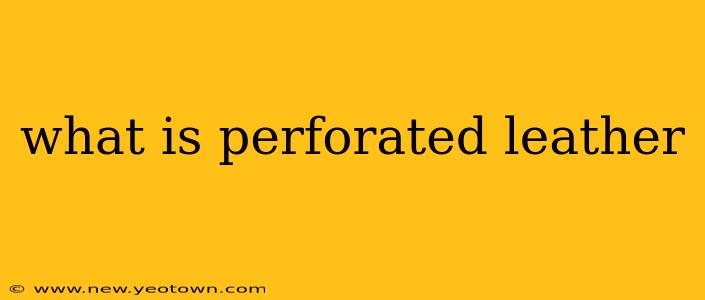Perforated leather is a type of leather that has small holes, or perforations, punched into its surface. This seemingly simple modification significantly alters the leather's properties, creating a unique aesthetic and impacting its functionality. This guide dives deep into everything you need to know about perforated leather, from its creation to its uses and benefits.
How is Perforated Leather Made?
The perforation process itself is relatively straightforward. Specialized machinery uses tiny punches or lasers to create precisely sized and spaced holes in the leather hide. The size, shape, and pattern of these perforations can vary dramatically, leading to a wide range of visual effects. Some common patterns include:
- Round holes: This is the most common type, often arranged in a regular grid.
- Square holes: Offers a slightly more geometric look.
- Custom patterns: More elaborate designs, sometimes incorporating logos or intricate shapes, are also possible.
The depth of the perforations also varies depending on the desired outcome. Shorter perforations maintain more of the leather's integrity, while deeper ones can create a more dramatic effect.
What are the Benefits of Perforated Leather?
The perforations aren't just for looks; they offer several key advantages:
- Breathability: This is perhaps the most significant benefit. The holes allow for increased air circulation, making perforated leather ideal for applications where comfort and ventilation are crucial, such as car seats, shoes, gloves, and clothing.
- Flexibility: Depending on the perforation pattern and depth, perforated leather can exhibit increased flexibility compared to its unperforated counterpart. This is particularly beneficial in applications requiring movement and articulation.
- Aesthetic appeal: The unique texture and visual interest created by the perforations add a touch of sophistication and style. This makes it a popular choice for high-end products.
- Reduced weight: By removing some of the leather material, perforation can result in a lighter final product.
What are the Different Uses of Perforated Leather?
The versatility of perforated leather makes it suitable for a vast range of applications, including:
- Automotive interiors: Car seats, steering wheels, and dashboards often feature perforated leather for its comfort and breathability.
- Apparel: Gloves, jackets, and shoes utilize perforated leather for its stylistic appeal and ventilation.
- Furniture: High-end furniture often incorporates perforated leather for a luxurious and breathable seating experience.
- Accessories: Wallets, belts, and bags can utilize perforated leather for its unique texture and durability.
Is Perforated Leather More Expensive Than Regular Leather?
Generally speaking, yes. The additional manufacturing step involved in perforating the leather adds to the overall cost. The intricacy of the perforation pattern also plays a role; more complex designs will typically be more expensive. However, the increased comfort, durability, and aesthetic appeal often justify the higher price point for many consumers.
How Do I Care for Perforated Leather?
Proper care is essential to maintain the quality and longevity of perforated leather. Avoid harsh chemicals and abrasive cleaners. Regular cleaning with a soft cloth and a specialized leather cleaner is recommended. Conditioning the leather periodically will help keep it supple and prevent cracking.
What is the Difference Between Perforated and Embossed Leather?
While both perforated and embossed leather alter the surface texture, they do so through different processes. Perforated leather involves punching holes through the material, whereas embossed leather uses heat and pressure to create raised or indented designs on the surface. Embossing doesn't create holes and thus does not improve breathability.
How Durable is Perforated Leather?
The durability of perforated leather depends on several factors, including the thickness and quality of the original leather hide, the depth and pattern of the perforations, and the type of finish applied. Generally, appropriately chosen perforated leather can be quite durable, especially when used in applications that aren't subject to excessive wear and tear. However, it's important to choose high-quality leather and care for it properly to extend its lifespan.
This comprehensive overview provides a deeper understanding of perforated leather, its creation process, advantages, uses, and care. Whether you're a designer, a manufacturer, or simply a consumer interested in this unique material, we hope this guide has been helpful.

